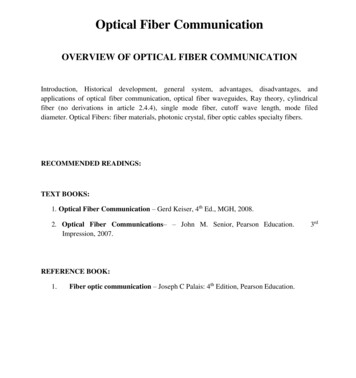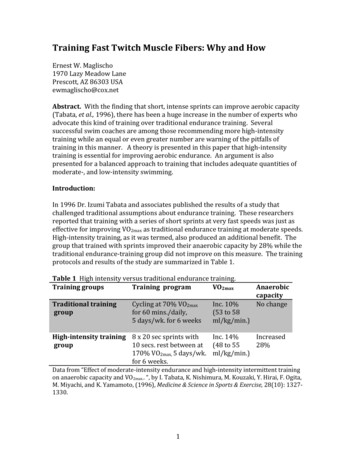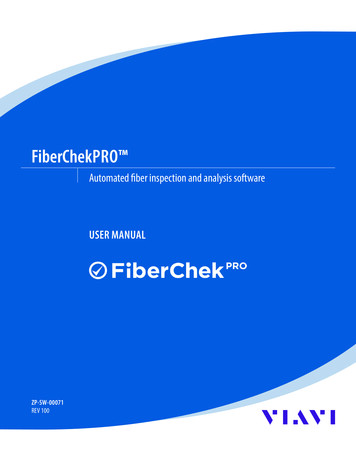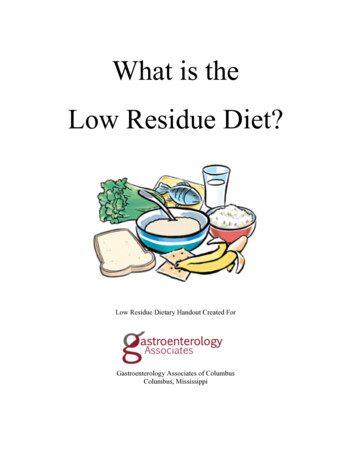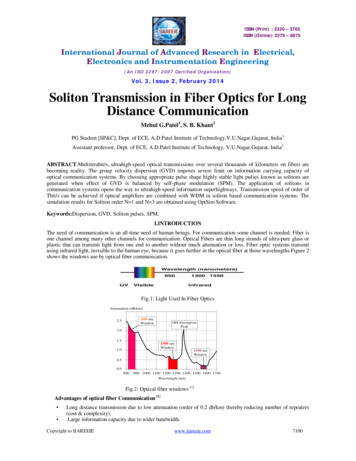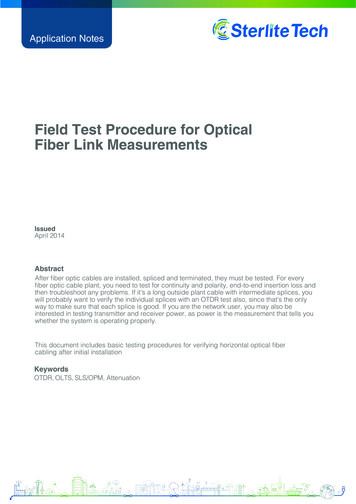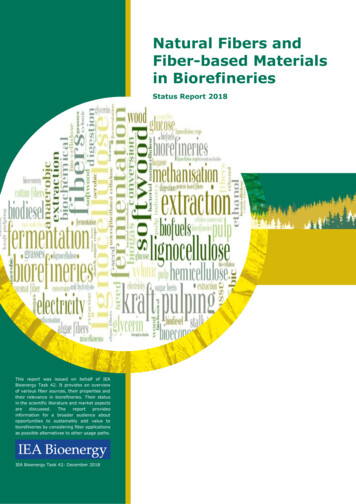
Transcription
Natural Fibers andFiber-based Materialsin BiorefineriesStatus Report 2018This report was issued on behalf of IEABioenergy Task 42. It provides an overviewof various fiber sources, their properties andtheir relevance in biorefineries. Their statusin the scientific literature and market aspectsarediscussed.Thereportprovidesinformation for a broader audience aboutopportunities to sustainably add value tobiorefineries by considering fiber applicationsas possible alternatives to other usage paths.IEA Bioenergy Task 42: December 2018
Natural Fibers and Fiber-based Materials in BiorefineriesStatus Report 2018Report prepared byJulia Wenger, Tobias Stern, Josef-Peter Schöggl (University of Graz), René van Ree (Wageningen Food and Bio-based Research), Ugo DeCorato, Isabella De Bari (ENEA), Geoff Bell (Microbiogen Australia Pty Ltd.), Heinz Stichnothe (Thünen Institute)With input fromJan van Dam, Martien van den Oever (Wageningen Food and Bio-based Research), Julia Graf (University of Graz), Henning Jørgensen(University of Copenhagen), Karin Fackler (Lenzing AG), Nicoletta Ravasio (CNR-ISTM), Michael Mandl (tbw research GesmbH), BorislavaKostova (formerly: U.S. Department of Energy) and many NTLs of IEA Bioenergy Task 42 in various discussionsDisclaimerWhilst the information in this publication is derived from reliable sources, and reasonable care has been taken in its compilation, IEABioenergy, its Task42 Biorefinery and the authors of the publication cannot make any representation of warranty, expressed or implied,regarding the verity, accuracy, adequacy, or completeness of the information contained herein. IEA Bioenergy, its Task42 Biorefinery andthe authors do not accept any liability towards the readers and users of the publication for any inaccuracy, error, or omission, regardlessof the cause, or any damages resulting therefrom. In no event shall IEA Bioenergy, its Task42 of the authors have any liability for loss ofprofits and/or indirect, special, punitive, or consequential damages.Copyright 2018 IEA Bioenergy. All rights ReservedISBN 978-1-910154-53-3Published by IEA Bioenergy Task 42IEA Bioenergy, also known as the Technology Collaboration Programme (TCP) for a Programme of Research, Development and Demonstrationon Bioenergy, functions within a Framework created by the International Energy Agency (IEA). Views, findings and publications of IEA Bioenergydo not necessarily represent the views or policies of the IEA Secretariat or of its individual Member countries.
EXECUTIVE SUMMARYThe biorefinery of the 21st century requires commercialization and policy support of currenttechnologies to allow the industry to grow. Companies that attempt to enter the field of renewableraw materials and products must be aware of prices, performance values and volumes available.Such information can speed up new developments. Finding suitable matches for raw materials withthe right industry and application may lead to improvements in the overall sustainability. Whilegaseous biofuels and liquid transportation fuels have a huge market volume (especially the latter),the product unit value created in these applications is limited. In contrast, biochemicals andbiomaterials tend to represent smaller markets, although within a very wide range from commoditiesto specialties, including certain niche markets. However, as the performance of some commercialbiorefineries suggests, a single biorefinery tends to develop product portfolios based on the highvalue-added products available, aggregating rather small markets, and the main product (inconjunction with the regional feedstock availability) defines the scale of the operation.Therefore, those responsible for the individual biorefineries are confronted with a decision-makingprocess whenever they consider the utilization of side streams and by-products, for example, fibrousresidues. This report identifies potential roles of biobased fibers and fiber-based materialsin biorefinery development. It was written to provide information to a wider audience bydescribing the added value of fiber materials in combination with energy carriers andother products from biorefineries.Several fiber products that originate from dedicated feedstock, as well as from residues, can playroles for biorefineries. In addition to the conventional systems, other, so-called “advancedbiorefinery types” are relevant with respect to fiber products, including:1.Compared to some other biorefinery types, such as whole-crop biorefineries, the“lignocellulosic-feedstock biorefinery” benefits from high feedstock availability, moderatecosts and no direct competition with food and feed production. The components (mainlycellulose, lignin and hemicellulose) are separated by using several available proceduresbefore they are further processed into various products and bioenergy. For instance, lignin,has mainly been burned as black liquor (in pulp processes) up until now, and chemicalrecovery has been used to generate energy (heat, electricity). However, lignin also has apotential to be used to create products such as renewable polymers or materials in thefuture. Fibers and fibrous products account for the largest proportion of the product portfolioin this type of biorefinery; therefore, the lignocellulosic-feedstock biorefinery can beconsidered especially relevant for the fiber report. A large variety of products (high-valueproducts and commodities) are traditionally produced from lignocellulosic sources, andmany new applications will most probably be based on this feedstock class (e.g.,nanomaterials).2.A “whole-crop biorefinery,” where a portfolio of products is produced from grain and strawfractions, the dried residue mash (combination of wet grains and syrup) is processed to“distiller’s dried grains with solubles,” which is used as cattle feed due to its high dietaryfiber content and its nutritional characteristics. The residual straw (i.e., the fraction whichis not needed on the ground for soil improvement) represents a lignocellulosic feedstockthat is processed in a lignocellulosic-feedstock biorefinery. The economic feasibility couldbe enhanced substantially by creating high value by producing by-products. Therefore,although fibers will most probably account for a much smaller share of the typical productportfolio (compared to lignocellulosic biorefineries) in this case, the consideration of the1
fiber compounds in this type of biorefinery is also relevant, particularly when it comes toadding value and moving towards a circular economy.3.The “oleo chemical biorefinery” uses oil crops for biodiesel production, combined with highadded-value, vegetable oil-based products; however, these face the global challenge ofmaintaining a balance between food, oleo chemical and energy uses when crude oil pricesincrease. Substantial amounts of additional biomass are generated as reusable residue, asseed oils only comprise approximately 5-10% of the total biomass. Therefore, the remainingparts of the plant (e.g., lignocellulose, press cake and hulls), which are not needed on theground to maintain the humus content and soil fertility (amounts depending on siteconditions), are available for valorization. As in the whole-crop biorefinery, fibers will mostprobably account for a rather small share of the typical product portfolio, and theadvantages of their optimized use could be to increase value and contribute to the circulareconomy.4.So-called “green biorefineries” use grassland for the production of fresh biomass (e.g.,grass for animal feed) and, therefore, take advantage of the fact that traditional grasslandutilization for cattle production is on the decline in some regions, such as in Europe. Usingvarious processes, fresh biomass is converted into a liquid phase (nutrient-rich green juicecontaining lactic acids, amino acids, proteins and other components) and a solid phase thatconsists mainly of fibers (press cake), and whose economic return is said to determine theeconomic efficiency of this biorefinery type. Thus, in addition to components such as proteinthat are used as animal feed, the fibers can be used to make material for building,insulation, and packaging applications, biocomposites, biofuel feedstock and other products.Improvements in grass fractionation still need to be achieved; however, if greenbiorefineries manage to be economically competitive, they would offer new opportunities inrural areas and contribute to the preservation of cultural landscapes and biodiversity.Several practical examples (companies, demo-scale facilities, research projects), which can becounted among these types of biorefineries, are described in more detail in the report, and some ofthe challenges that advanced biorefinery types are facing are illustrated.In addition to these practical examples, fibers and fibrous materials are considered in state-of-theart biorefinery research. Considering 657 abstracts from scientific articles published aboutbiorefineries between 2010 and 2016, the importance of lignocellulosic feedstock in biorefinerydevelopment is dominant. In addition to wood as a major feedstock for fibers, grass plants (such asswitch grass) are mentioned and used to a small extent as a source for fibers. The fiber press cakefrom green biorefineries, meanwhile, is often intended to serve as animal feed or insulation material.Biorefinery fibers tend to be mentioned in the context of residue utilization (especially from commonagricultural crops like corn, wheat and sugarcane). Concerning residuals from starch and sugarcrops, a strong focus has been placed on energy utilization (fuels) as compared to materialexploitation in the underlying search. However, products such as composites, pulp and paper havealso been partly considered. In scientific articles, residuals from oil crops are rather frequently usedas fiber material (in 50% of the abstracts), for instance, due to their good self-bonding propertiesas insulation fiberboards. Composite reinforcements, nanomaterials, boards (mainly for insulation),pulp and paper products, carbon fibers from lignin, feed and dietary fibers are applications that wererelatively frequently mentioned in these abstracts.Many feedstock which provide a source for natural fibers (e.g., cotton, flax, hemp and jute) aresuitable for biorefinery concepts but are not often considered in terms of biorefinery development.The supply of these traditional natural-fiber feedstock is rather limited; therefore, the resultingbiorefinery concepts are difficult to develop.2
In contrast, agricultural feedstock that are commonly available, like wheat or maize, are more oftenutilized in biorefinery concepts, but fiber products are rarely considered as an option in productportfolio development.Compared to some other biorefinery products like fuels, the applications and markets associatedwith fiber products must be considered as relatively diverse and complex. Unlike the fuel-bio-fuelsubstitution, for example, the replacement of glass fibers (as well as petrochemical-based carbonfiber) does not depend entirely on the cost. Therefore, fiber products open opportunities to buildbiorefinery development pathways in the future.A future economy that sustainably uses biobased resources instead of fossil fuels to meet people’sneeds will be dependent on the production of a variety of products such as food, feed, materials,chemicals and energy from limited resources, such as the amount of land available for cultivation.The possibility to produce “almost everything from almost everything,” although resources arescarce (e.g., land, energy, water and nutrients), contributes to the necessity of using theseresources as efficiently as possible.In particular, it is expected that several issues and developing technologies will affect the topic offibers and fiber-based materials in biorefineries in the future. The production of micro- and nanofibrillated cellulosic materials, for example, could lead to many promising applications (e.g., films,nanocomposites, coatings, pharmaceuticals, separation membranes, rheological modifiers andbiomedical applications). The use of lightweight, high-performance materials in vehicles is aprominent topic that touches on energy issues in the transportation sector, e.g., in the context ofe-mobility; on this matter, the use of natural-fiber reinforced composites is a field in whichincreasing interest has been shown. Carbon fibers are already produced from natural resources toa small extent (e.g., from wood-based rayon), but lignin from wood biorefineries is also a potentialprecursor for biobased carbon fiber production. The strong growth of mail-order businesses adds tothe necessity to pack products safely. Therefore, fibrous packaging materials such as paperboardwill remain relevant, while the development of smart, biobased packaging materials can also beexpected. The so-called fast fashion trend has supported the production of cheap synthetic andcotton fibers in recent years, while certain other segments of the textile industry (e.g., fair fashion,outdoor clothing) have recognized that sustainability is a relevant issue. Driven by increasingconsumer awareness, the sustainable production of textiles (e.g., from natural fibers grown on aregional level) is increasing in relevance. This could be another opportunity for the use of sustainablefibers from biorefineries. In the context of resource efficiency and the circular economy, technologiesfor waste recycling and residue valorization will become of even greater importance. For instance,the biotechnological conversion of cellulose extracted from municipal solid waste into products suchas sugars and ethanol can offer several advantages. These include creating added value by recyclingof waste materials, saving GHG emissions and producing renewable energy without creatingcompetition for food and land use.3
CONTENTSEXECUTIVE SUMMARY . 11.INTRODUCTION . 52.BIOREFINERIES – CONCEPT AND UTILIZATION OF NATURAL FIBERS . 62.1 Definition, driving forces and motivation . 62.2 Market aspects . 72.3 Classifications . 82.4 The role of natural fibers . 83. FIBERS WITH RELEVANCE FOR BIOREFINERIES . 113.1 Natural Fibers . 163.2 Man-made fibers . 243.3 Market value and volume of selected fiber types and referenceproducts . 304. APPLICATIONS . 334.1 Paper. 334.2 Fiber-based boards . 344.3 Textiles . 344.4 Composites . 364.5 Insulation materials for buildings . 374.6 Food and feed . 374.7 Market value and volume of selected fiber applications . 385. BIOREFINERY EXAMPLES . 405.1 Industrial best practices. 405.2 Demonstration and research . 446. DISCUSSION AND CONCLUSIONS . 46REFERENCES . 484
1.INTRODUCTIONThe concept of sustainably processing biomass into a spectrum of marketable biobased products(food/feed ingredients, chemicals, materials) and bioenergy (fuels, power and/or heat) is not new.Thousands of years ago, for example, production techniques for vegetable oils or wine had alreadybeen developed, and in the 19th and 20th centuries, large-scale utilization of renewable resources(e.g., sugar – with an industrial biorefinery) already existed. Scientists placed a focus at that timealso on topics related to fiber (Kamm et al., 2016) and, namely, on the “pulp and paper productionfrom wood, saccharification of wood, nitration of cellulose for guncotton and viscose silk, productionof soluble cellulose for fibers, fat curing, and the production of furfural for nylon” (Kamm et al.,2016; De Jong et al., 2015). However, the term “biorefinery” did not appear until the 1990’s, whensome industrial trends developed to utilize biomass. These trends included: increased policy- andconsumer-driven awareness of the need to use biomass resources in an economically andenvironmentally (e.g., reduced CO2 emissions), more rational way; a growing interest in biomassupgrading to valuable products; a greater consideration for starch utilization for fuel production;and “a perceived need to develop more high-value products and diversify the product mix in orderto meet global competition and, in some cases, utilize an excess of biomass (especially in the pulpand paper industry)” (Berntsson et al., 2014; Kamm et al., 2016).Ragauskas and colleagues (2006) outlined their ideas of a research road map for the biorefinery ofthe 21st century and found that commercialization and policy support concerning current and nearterm technologies are required to allow the industry grow. Keijsers et al. (2013) stated that it wasimportant for industries to become aware of the price, performance value and volumes availablewhile trying to utilize renewable raw materials. They concluded that such information can speed upnew developments and that a suitable match of raw materials with the right industry and applicationcould lead to improvements in the overall sustainability levels. Chambost and Stuart (2007)described the basis for a systematic product design methodology for Rapid Market Analysis, anapproach that was suitable for evaluating the economic and commercial potential of a biorefineryproject and used a set of business tools that included market and synergy identification. Theselection of appropriate methods for decision support, which needs to be adapted to the individualcase, is discussed in chapter 4.7.This report identifies the potential roles of natural fibers and fiber-based materials inbiorefinery development. It was written to provide information for a wider audience bydescribing the potential added value of fiber materials in combination with secondaryenergy carriers and other products from biorefineries and addressing the followingquestions: 1) How can natural fibers and fiber-based materials increase the value addedby biorefineries? 2) How can natural fibers and fiber-based materials from biorefineriesbe classified and selected by applying clear criteria? 3) How can the relevance of naturalfibers and fiber-based materials for biorefineries be determined?Therefore, a general overview on natural fiber classification and natural fiber markets is firstintroduced in the study. Thereafter, certain natural fiber types that are potentially relevant forbiorefineries are described in more detail. The most important technical natural-fiber applicationsare described based on their requirements. This information should enable the reader to roughlyassess the usability and value of natural fibers or fiber-based materials that may be obtained frombiorefining processes. A detailed case-to-case assessment is, however, a matter of consideringindividual framework conditions. Therefore, the report introduces some useful approaches that canbe taken to perform such assessments. Finally, the report provides some best-practice examplesthat may be taken as references for future developments.5
2.BIOREFINERIES – CONCEPT AND UTILIZATION OFNATURAL FIBERS2.1 Definition, driving forces and motivationSeveral definitions of the term biorefining exist, such as the definition provided by IEA BioenergyTask 42, which defined it as the “sustainable processing of biomass into a spectrum of marketablebiobased products (chemicals, materials) and bioenergy (fuels, power, and/or heat)” (De Jong etal., 2011), and that provided by the American National Renewable Energy Laboratory (NREL), whichstated that “a biorefinery is a facility that integrates biomass conversion processes and equipmentto produce fuels, power and chemicals from biomass” (Berntsson et al., 2014).Therefore, biorefineries can be regarded as analogous to petrochemical refineries, where crude oilis fractionated into a large number of intermediates and further processed into a variety of finalproducts by elaborate procedures, as shown in Figure 1. Biorefineries have different prerequisites,however, compared to petrochemical refineries, such as the variety of feedstock, the necessity fora larger range of processing technologies and the variability in quality and energy density (Clark etal., 2015; Türk, 2014; De Jong, 2015).Figure 1: Comparison of the basic principles of petroleum refineries and biorefineries (modified from Clarket al., 2015 and from Kamm et al., 2016)There are various driving forces behind the growing interest in moving from a fossil-resource-basedeconomy towards a biobased economy. Major key motives include the expected peak production ofnon-renewable resources in the near future as well as price volatilities and increases; the desire toreduce the heavy dependence on imports of fossil fuel resources; the opportunities to promoteregional and rural development; the chance to reduce GHG emissions to mitigate climate change;waste minimization; and the increased awareness of the importance of an economically,environmentally and socially sustainable global economy (De Jong et al., 2011; De Jong et al.,2015).6
Several other parameters influence the success of biorefineries, such as the invitation of keystakeholders from separate backgrounds (e.g., agriculture/forestry, transportation fuels, chemicals,energy) to discuss various processing topics, encourage necessary R&D activities and deploydeveloped technologies in multi-disciplinary partnerships (De Jong et al., 2015).In a sustainable biobased economy, a variety of products, such as food, feed, materials, chemicalsand energy, must be produced from limited resources. The possibility to produce “almost everythingfrom almost everything”, although resources (e.g., amount of land available for cultivation, energy,water, and nutrients) are scarce, contributes to the necessity of using these resources as efficientlyas possible to meet people’s needs. “Using the Earth's limited resources in a sustainable mannerwhile minimizing impacts on the environment” is the definition of resource efficiency used by the EC(European Commission, 2017), which strives to achieve sustainable growth using the means of aresource-efficient and low-carbon economy. To achieve this goal, well-developed technologies,tailored management and logistics, optimized product portfolios, but also sustainable consumptionpatterns, fair distribution and circular economy issues need to be considered. Some key terms andwords that are used to describe the concept of the so-called circular economy include “maintainingthe value of products and materials,” “minimization of waste and resources” and “re-use” (EuropeanCommission, 2018). The concept of shifting from open-ended to more circular economic systemscan be traced back to the 1960s (idea: Boulding, 1966) and late 1980s (theoretical framework:Pearce and Turner, 1989) and has been the subject of research and discussion since these times.The principles “Reduction, Reuse and Recycle” (the so-called 3Rs Principles) are the three actionswith which circular economy is mainly associated (Ghisellini et al., 2016). Political actions towardsa more circular economy have been taken, for example, by Japan, China and countries in theEuropean Union (Mair et al., 2016).The primary motivation to develop biorefinery concepts can either be the production of energy orbiofuel (“energy-based biorefinery”) or the production of a portfolio of biobased products (“productbased biorefinery”). Energy-based biorefineries focus on the production of liquid or gaseous roadtransportation biofuels, power or heat, however, also produce value-added products from residuesto get additional economic and environmental benefits. Product-based biorefineries try to gain thehighest economic benefit by fractionating and modifying biomass into a portfolio of biobasedproducts (including natural fibers), also partly using process residues to gain energy.2.2 Market aspectsA typical pattern that occurs in context of multi-product biorefineries is related to the ratio of theproduct value and associated market volume: The higher the product value, the smaller theassociated market volume (specialties) and vice versa (commodities) (Stern et al., 2015). Whilegaseous biofuels and liquid transportation fuels have an enormous market volume (especially thelatter), the product unit value created in these applications is limited (Lora, 2006; Berlin andBalakshin, 2014). In contrast, biochemicals, biomaterials and hybrids thereof tend to representsmaller markets, although within a very wide range from commodities to specialties, includingcertain niche markets. However, if single biorefineries (one site/factory/mill) are examined, theproduct portfolios based on several high value-added by-products seem to create a higher returnthan a combination of products with one dominating commodity. This rather theoretical perspectiveis, in practice, supported by the fact that fuel and chemical markets reflect the economies of scaleof petrochemical industries. In contrast, biorefineries will never reach the average scale of operationthat is available at petrochemical refineries. This fact is based on fundamental differences regardingfeedstock supply. While oil fields and pipelines provide a centralized supply, biomass is produceddecentrally. Hence, the scale of operation must reflect the availability of the required feedstock inan area that is defined by reasonable transportation costs (Jack, 2009).7
The extension of this relation depends on the individual feedstock. Processing green, perishablefeedstock (grasses), for example, will require the use of small-scale facilities that produce proteinrich juices and fiber materials. Imported lignocellulosic feedstock, on the other hand, probably willbe processed in relatively large-scale facilities to produce chemicals/materials and secondary energycarriers in an efficient and synergistic way.Still, whenever decision-makers of biorefinery operations consider the utilization of additional sidestreams and by-products, such as fibrous residues, the target products and markets including thetarget values and volumes need to be defined.Lignocellulosic residues, such as agricultural residues (e.g., straws and stalks) are a source of fibersthat can also have environmental and economic advantages (Puitel et al., 2015). These have beendiscussed for the production of fiber panels, particleboard plants, or composites based on severalfeedstock and, to a minor extent, for the production of insulation boards and other buildingmaterials, adding value to biorefineries (e.g., towards the concept of a whole-crop biorefinery)(Philippou, 2001).2.3 ClassificationsTo cope with the rising number and complexity of biorefineries, several classification approacheshave been introduced.IEA Bioenergy Task 42 has developed a specific classification approach which is applicable toindividual biorefinery systems and their possible combinations. In this approach, four main featuresare distinguished: 1) platforms (e.g., C5 and C6 sugars, oils, biogas); 2) products (energy products,such as electricity/heat or bioethanol; material products, biomaterials, or polymers); 3) feedstock(dedicated crops, such as oil crops, sugar crops, grasses; residues, such as lignocellulosic residues);and 4) processes (e.g., thermochemical, biochemical, chemical, mechanical) (Cherubini et al., 2009;De Jong et al., 2011).Examples for the application of the classification system include: A C5/C6 sugars and lignin biorefinery for the biochemical processing of straw for theproduction of bioethanol, power and heat. A syngas biorefinery for the thermochemical processing of wood for the production ofbioethylene, power and heat.2.4 The role of natural fibersFrom a technical point of view, almost all industrial materials based on fossil resources can besubstituted by biobased equivalents (Raschka et al., 2012). However, these often cannot yetcompete economically, based on the premises that they perform at least as well as the petrochemicalcou
The biorefinery of the 21st century requires commercialization and policy support of current technologies to allow the industry to grow. Companies that attempt to enter the field of renewable raw materials and products must be aware of prices, performance values and volumes available. Such information can speed up new developments.

